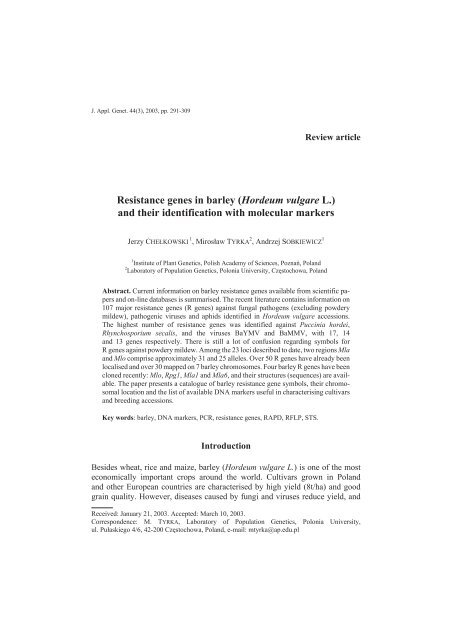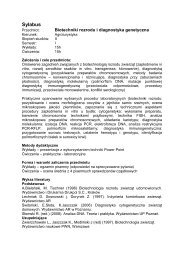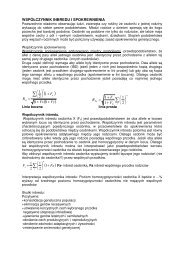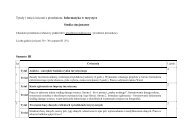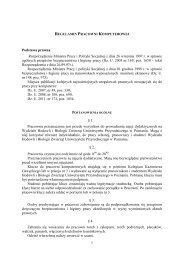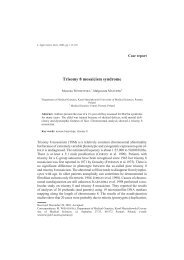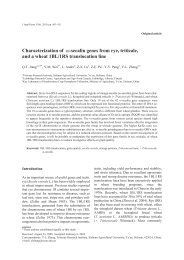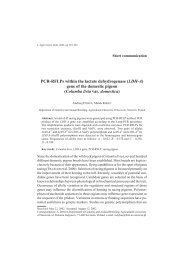Resistance genes in barley (Hordeum vulgare L.) and their ...
Resistance genes in barley (Hordeum vulgare L.) and their ...
Resistance genes in barley (Hordeum vulgare L.) and their ...
You also want an ePaper? Increase the reach of your titles
YUMPU automatically turns print PDFs into web optimized ePapers that Google loves.
J. Appl. Genet. 44(3), 2003, pp. 291-309<br />
Review article<br />
<strong>Resistance</strong> <strong>genes</strong> <strong>in</strong> <strong>barley</strong> (<strong>Hordeum</strong> <strong>vulgare</strong> L.)<br />
<strong>and</strong> <strong>their</strong> identification with molecular markers<br />
Jerzy CHE£KOWSKI 1 , Miros³aw TYRKA 2 , Andrzej SOBKIEWICZ 1<br />
1 Institute of Plant Genetics, Polish Academy of Sciences, Poznañ, Pol<strong>and</strong><br />
2 Laboratory of Population Genetics, Polonia University, Czêstochowa, Pol<strong>and</strong><br />
Abstract. Current <strong>in</strong>formation on <strong>barley</strong> resistance <strong>genes</strong> available from scientific papers<br />
<strong>and</strong> on-l<strong>in</strong>e databases is summarised. The recent literature conta<strong>in</strong>s <strong>in</strong>formation on<br />
107 major resistance <strong>genes</strong> (R <strong>genes</strong>) aga<strong>in</strong>st fungal pathogens (exclud<strong>in</strong>g powdery<br />
mildew), pathogenic viruses <strong>and</strong> aphids identified <strong>in</strong> <strong>Hordeum</strong> <strong>vulgare</strong> accessions.<br />
The highest number of resistance <strong>genes</strong> was identified aga<strong>in</strong>st Pucc<strong>in</strong>ia hordei,<br />
Rhynchosporium secalis, <strong>and</strong> the viruses BaYMV <strong>and</strong> BaMMV, with 17, 14<br />
<strong>and</strong> 13 <strong>genes</strong> respectively. There is still a lot of confusion regard<strong>in</strong>g symbols for<br />
R <strong>genes</strong> aga<strong>in</strong>st powdery mildew. Among the 23 loci described to date, two regions Mla<br />
<strong>and</strong> Mlo comprise approximately 31 <strong>and</strong> 25 alleles. Over 50 R <strong>genes</strong> have already been<br />
localised <strong>and</strong> over 30 mapped on 7 <strong>barley</strong> chromosomes. Four <strong>barley</strong> R <strong>genes</strong> have been<br />
cloned recently: Mlo, Rpg1, Mla1 <strong>and</strong> Mla6, <strong>and</strong> <strong>their</strong> structures (sequences) are available.<br />
The paper presents a catalogue of <strong>barley</strong> resistance gene symbols, <strong>their</strong> chromosomal<br />
location <strong>and</strong> the list of available DNA markers useful <strong>in</strong> characteris<strong>in</strong>g cultivars<br />
<strong>and</strong> breed<strong>in</strong>g accessions.<br />
Key words: <strong>barley</strong>, DNA markers, PCR, resistance <strong>genes</strong>, RAPD, RFLP, STS.<br />
Introduction<br />
Besides wheat, rice <strong>and</strong> maize, <strong>barley</strong> (<strong>Hordeum</strong> <strong>vulgare</strong> L.) is one of the most<br />
economically important crops around the world. Cultivars grown <strong>in</strong> Pol<strong>and</strong><br />
<strong>and</strong> other European countries are characterised by high yield (8t/ha) <strong>and</strong> good<br />
gra<strong>in</strong> quality. However, diseases caused by fungi <strong>and</strong> viruses reduce yield, <strong>and</strong><br />
Received: January 21, 2003. Accepted: March 10, 2003.<br />
Correspondence: M. TYRKA, Laboratory of Population Genetics, Polonia University,<br />
ul. Pu³askiego 4/6, 42-200 Czêstochowa, Pol<strong>and</strong>, e-mail: mtyrka@ap.edu.pl
292 J. Che³kowski et al.<br />
the quality of both spr<strong>in</strong>g <strong>and</strong> w<strong>in</strong>ter cultivars depend on seasonal conditions. Barley<br />
has recently been studied extensively <strong>in</strong> relation to the mapp<strong>in</strong>g of major resistance<br />
<strong>genes</strong> (R <strong>genes</strong>) <strong>and</strong> partial disease resistance <strong>genes</strong> as well as QTL l<strong>in</strong>ked to<br />
resistance reaction (CHEN et al. 1994, BACKES et al. 1995, THOMAS et al. 1995,<br />
ATTARI et al. 1998, KICHERER et al. 2000, SCHEURER et al 2001).<br />
The <strong>barley</strong> genome (HH, 2n = 2x = 14) is among the largest genomes of cultivated<br />
plants, with the size of 4873 Mbp per haploid nucleus (ARUMUGANATHAN,<br />
EARLE 1991). Comparative studies of wheat, rye <strong>and</strong> <strong>barley</strong> genetic maps show<br />
that apart from a number of gross chromosome rearrangements (such as the position<br />
of nucleolus organiser regions), the order of loci <strong>in</strong> these crop species is very<br />
similar, reflect<strong>in</strong>g a general evolutionary conservation of l<strong>in</strong>kage group structure.<br />
Information on the comparative mapp<strong>in</strong>g of cereals can be found at the Gramene<br />
HomePage (http://www.gramene.org/)(<strong>in</strong>dex.html). Recent data on <strong>genes</strong> identified<br />
<strong>in</strong> <strong>barley</strong>, <strong>their</strong> symbols <strong>and</strong> mapp<strong>in</strong>g on chromosomes are reviewed every<br />
year. Updates are available <strong>in</strong> the on-l<strong>in</strong>e database: http://wheat.pw.usda.gov/<br />
ggpages/bgn/.<br />
Some disease resistance <strong>genes</strong> (R <strong>genes</strong>) conta<strong>in</strong> conserved sequence motifs,<br />
like the nucleotide-b<strong>in</strong>d<strong>in</strong>g site (NBS) <strong>and</strong> leuc<strong>in</strong>e-rich repeats (LRR). An <strong>in</strong>terest<strong>in</strong>g<br />
feature of this class of R <strong>genes</strong> is that they are <strong>in</strong>volved <strong>in</strong> gene-for-gene resistance<br />
towards either fungal, viral, bacterial or nematode disease resistance.<br />
The conservation between different NBS-LRR resistance <strong>genes</strong> opens the possibility<br />
for the use of polymerase cha<strong>in</strong> reaction (PCR)-based strategies for isolat<strong>in</strong>g<br />
<strong>and</strong> clon<strong>in</strong>g other R gene family members or analogs us<strong>in</strong>g degenerate or specific<br />
primers for these conserved regions (see review of BENT et al. 1994, WHITHAM<br />
et al. 1994, GRANT et al. 1995, LAWRENCE et al. 1995, BAKER et al. 1997,<br />
LAGUDAH et al. 1997, YU et al. 2000). Specific primer sequences derived from<br />
a previously isolated NBS-LRR sequence at the Cre3 locus, which confers resistance<br />
to the cereal cyst nematode (CCN) <strong>in</strong> wheat (Triticum aestvum L.), were<br />
used to isolate a family of resistance gene analogs (RGAs) through a polymerase<br />
cha<strong>in</strong> reaction (PCR) clon<strong>in</strong>g approach. This class of R gene belongs to<br />
a superfamily that is present <strong>in</strong> both dicotyledons <strong>and</strong> monocotyledons, as suggested<br />
from sequence comparisons of those that have been isolated. Such analyses<br />
have revealed several highly conserved functional am<strong>in</strong>o acid motifs, notably<br />
the NBS sequences (P-loop <strong>and</strong> K<strong>in</strong>ase-2a) <strong>and</strong> others of unknown function between<br />
the NBS <strong>and</strong> LRR region (SEAH et al. 1998).<br />
The number of named <strong>and</strong> mapped resistance <strong>genes</strong> <strong>in</strong> <strong>barley</strong> <strong>in</strong>creased significantly<br />
<strong>in</strong> the last decade (Table 1). At present a catalogue of gene symbols for <strong>barley</strong><br />
is not available. There is a “Catalogue of gene symbols for wheat”, which has<br />
been published <strong>and</strong> is also updated on-l<strong>in</strong>e, <strong>in</strong>itiated about 32 years ago<br />
(MCINTOSH et al. 1998). Knowledge of the effectiveness of <strong>barley</strong> resistance<br />
<strong>genes</strong> <strong>and</strong> l<strong>in</strong>ked DNA markers, along with detailed characteristics of genetic<br />
stocks, can improve breed<strong>in</strong>g strategies. The aim of this work was to collect <strong>in</strong>for-
<strong>Resistance</strong> <strong>genes</strong> <strong>in</strong> <strong>barley</strong> 293<br />
Table 1. Symbols of identified major resistance <strong>genes</strong> (R) aga<strong>in</strong>st 15 fungal pathogens,<br />
four viruses <strong>and</strong> two pests <strong>in</strong> <strong>barley</strong>. (Complete list of <strong>barley</strong> diseases can be found at<br />
www.apsnet.org/onl<strong>in</strong>e/common/names/<strong>barley</strong>.asp)<br />
Gene symbol Pathogen/pest (<strong>and</strong> caused disease)<br />
Number<br />
of <strong>genes</strong><br />
Rph Pucc<strong>in</strong>ia hordei (leaf rust) 17<br />
Rpg Pucc<strong>in</strong>ia gram<strong>in</strong>is (stem rust) 4<br />
Rps Pucc<strong>in</strong>ia striiformis f. sp. hordei (stripe rust) 4<br />
Ml (Reg) Erysiphe gram<strong>in</strong>is f. sp. hordei (powdery mildew) 23<br />
Rcs Cochliobolus sativus (spot blotch) 5<br />
Rpt Pyrenophora teres (net blotch) 6<br />
Rdg (Rhg) Pyrenophora gram<strong>in</strong>ea (<strong>barley</strong> stripe) 3<br />
Rrs (Rh) Rhynchosporium secalis (scald) 14<br />
Run (un) Ustilago nuda (loose smut) 8<br />
Ung Ustilago nigra (semiloose smut) 1<br />
Ruh Ustilago hordei (covered smut) 4<br />
Rsp Septoria passer<strong>in</strong>i (leaf blotch) 3<br />
Rti Typhula <strong>in</strong>carnata (gray snow mold) 1<br />
fb Fusarium spp. (scab) 1<br />
Ryd BYDV (<strong>barley</strong> yellow dwarf virus) 2<br />
Rym (ym) BaYMV (<strong>barley</strong> yellow mosaic virus)<br />
BaMMV (<strong>barley</strong> mild mosaic virus)<br />
13<br />
Rsm (sm) BSMV (<strong>barley</strong> stripe mosaic virus) 5<br />
Rsg Schizaphis gram<strong>in</strong>um (green bug-aphid) 3<br />
Rha Heterodera avenae (cereal cyst nematode) 3<br />
Reg – several symbols are used <strong>in</strong> the literature for resistance <strong>genes</strong> aga<strong>in</strong>st Erysiphe gram<strong>in</strong>is, like Mlo, Mla,<br />
MILa <strong>and</strong> Reg<br />
mation on <strong>barley</strong> resistance <strong>genes</strong>, <strong>their</strong> mapp<strong>in</strong>g <strong>and</strong> DNA markers available for<br />
marker-assisted selection (MAS).<br />
<strong>Resistance</strong> <strong>genes</strong> identified <strong>in</strong> <strong>barley</strong><br />
Marker technology is mov<strong>in</strong>g from hybridization-based RFLP markers to<br />
PCR-based markers, as the latter are more economical <strong>and</strong> enable high sample<br />
throughput <strong>and</strong> simultaneous analysis of multiple loci. Sequence-tagged sites<br />
(STSs) (OLSON et al. 1989) <strong>and</strong> r<strong>and</strong>om amplified polymorphic DNAs (RAPDs)<br />
(WILLIAMS et al. 1991) are the most common PCR markers used to date <strong>in</strong> gene<br />
identification <strong>in</strong> plants. However, the mapp<strong>in</strong>g of resistance <strong>genes</strong> has utilised
294 J. Che³kowski et al.<br />
1H (5) 2H (2) 3H (3) 4H (4) 5H (7) 6H (6) 7H (1)<br />
Rph4<br />
Mlra<br />
Rti<br />
Rrs14<br />
Mla*<br />
Rps4<br />
Mla6<br />
Mlk<br />
Mlnn<br />
MlGa<br />
run8<br />
Rph16<br />
Rpt3<br />
Rha2<br />
Rph15<br />
MlLa<br />
Rph7<br />
Rrs1/3/4<br />
Rpt1<br />
Ryd2<br />
Rph10<br />
rym4<br />
rym5<br />
rym1<br />
rym11<br />
Mlg<br />
mlo<br />
rym9<br />
rym8<br />
RphTR<br />
Rph2<br />
Ym3<br />
AFLP (amplified fragment length polymorphism), SSR (simple sequence repeat)<br />
<strong>and</strong> RGAP (resistance gene analog polymorphism) techniques.<br />
There are two nomenclature systems for <strong>barley</strong> chromosomes. Our merg<strong>in</strong>g<br />
of previous maps published by FRANCKOWIAK (1997), JENSEN (2002)<br />
<strong>and</strong> KLEINHOFS (2002), <strong>and</strong> the map available on the Barley Genomics page<br />
of Wash<strong>in</strong>gton State University (http://<strong>barley</strong>genomics.wsu.eu/arnis/l<strong>in</strong>kage_maps/<br />
maps-svg.html) resulted <strong>in</strong> a consensus map of <strong>barley</strong> disease resistance<br />
<strong>genes</strong> (Figure 1). This map was supplemented with resistance <strong>genes</strong> Rgd2a,<br />
Rrs2, Rpt4 <strong>and</strong> Rpt3 (WILLIAMS et al. 1999, MOLNAR et al. 2000, SCHWEIZER et<br />
al. 2000, TACCONI et al. 2001).<br />
Mlj<br />
rym3<br />
Rha4<br />
Rph9/12<br />
rpg4<br />
Rrs13<br />
Rph11<br />
Figure 1. Consensus map of identified resistance <strong>genes</strong> (* complex locus)<br />
mlt<br />
Rpg1<br />
Run1<br />
Rgd2a<br />
Rrs2<br />
Rcs5<br />
rsm1<br />
Rpt4<br />
Rym2<br />
Rph3<br />
Mlf
Table 2. DNA markers developed for resistance <strong>genes</strong> <strong>in</strong> <strong>barley</strong> (<strong>Hordeum</strong> spp.)<br />
Gene symbol<br />
Chromosomelocalisation<br />
Orig<strong>in</strong> Marker type Reference<br />
Rph2 7HS H. <strong>vulgare</strong> RAPD, STS, RFLP BOROVKOVA et al. (1997)<br />
Rph7 H. <strong>vulgare</strong> CAPS GRANER et al. (2000)<br />
RFLP, STS-ASA BRUNNER ET al. (2000)<br />
Rph9, 12 5HL H. <strong>vulgare</strong> STS BOROVKOVA et al. (1998)<br />
Rph16 H. <strong>vulgare</strong> ssp.<br />
spontaneum<br />
STS, CAPS IVANDIC et al. (1998)<br />
Rpg1 1H H. <strong>vulgare</strong> RFLP JIN et al. (1993)<br />
Mla 1H H. <strong>vulgare</strong> RFLP KINTZIOS et al. (1995)<br />
Mlg 4HS H. <strong>vulgare</strong> RFLP GÖRG et al. (1993)<br />
KURTH et al. (2001)<br />
MlLa 2HL H. laevigatum RFLP, STS GIESE et al. (1993)<br />
Mlo 4HL H. <strong>vulgare</strong> RFLP<br />
HINZE et al. (1991)<br />
AFLP<br />
SIMONS et al. (1997)<br />
Ml-a 5H H. <strong>vulgare</strong> ssp. RFLP JAHOOR, FISCHBECK<br />
spontaneum<br />
(1993)<br />
rcs 6H H. <strong>vulgare</strong> RAPD<br />
KUTCHER, BAILEY (1994)<br />
Rpt1 RFLP GRANER et al. (1996)<br />
Rpt3 2H H. <strong>vulgare</strong> RAPD MOLNAR et al. (2000)<br />
Rpt4 7HL H. <strong>vulgare</strong> RFLP WILLIAMS et al. (1999)<br />
Rgd2a 7HS H. <strong>vulgare</strong> STS, CAPS TACCONI et al. (2001)<br />
Rrs1 3H H. <strong>vulgare</strong> RFLP, RAPD BARUA et al. (1993)<br />
AFLP WILLIAMS et al. (2001)<br />
Rrs2 7HS H. <strong>vulgare</strong> RFLP, RAPD SCHWEIZER et al. (1995,<br />
2000)<br />
Rrs13 6HS H. <strong>vulgare</strong> ssp.<br />
spontaneum<br />
RFLP ABBOTT et al. (1995)<br />
Rrs14 1HS H. <strong>vulgare</strong> ssp.<br />
spontaneum<br />
RFLP, STS GARVIN et al. (2000)<br />
run8 1H H. <strong>vulgare</strong> SSR<br />
LI et al. (2000)<br />
STS-ASA<br />
ECKSTEIN et al. (2002)<br />
Ruh H. <strong>vulgare</strong> RAPD, SCAR ARDIEL et al. (2002)<br />
Ryd2 H. <strong>vulgare</strong> AFLP PALTRIDGE et al. (1998)<br />
rym4 3HL H. <strong>vulgare</strong> RFLP GRANER, BAUER (1993),<br />
TUVESSON et al. (1998)<br />
RAPD, SSR ORDON et al. (1994)<br />
rym5 H. <strong>vulgare</strong> CAPS, SSR GRANER et al. (1999)<br />
rym8 H. <strong>vulgare</strong> RAPD BAUER et al. (1997)<br />
rym9 H. <strong>vulgare</strong> STS, SSR WERNER et al. (2000)<br />
rym11 H. <strong>vulgare</strong> RAPD, SSR BAUER et al. (1997)<br />
rym13 H. <strong>vulgare</strong> SSR ORDON et al. (2003)
Table 3. Catalogue of resistance gene symbols for <strong>barley</strong><br />
Locus symbol a Synonyms Chromosomelocation<br />
Parental cultivar (source) Gene reference b<br />
1 2 3 4 5<br />
Reaction to Pucc<strong>in</strong>ia hordei<br />
Rph1 Pa 2H Oderbrucker BGN 26:107<br />
Rph2b,j,k,l,m,n,<br />
q,r,s,t,u,y,<br />
Pa2 5HS BGN 26:126<br />
FRANCKOWIAK et al. (1996)<br />
Rph3c,w,aa Pa3 7HL Estate BGN 26:156<br />
FRANCKOWIAK et al. (1996)<br />
Rph4 Pa4 1HS Gull BGN 26:217<br />
Rph5 Pa5 3HS Magnif 102 BGN 26:157<br />
Rph6 Pa6 3HS Bolivia BGN 26:501<br />
Rph7g,ac Pa7 3HS Cebada Capa BGN 26:173<br />
FRANCKOWIAK et al. (1996)<br />
Rph8 Pa8 Egypt 4 BGN 26:502<br />
Rph9 Pa9,<br />
Rph12<br />
5HL HOR 2596 BOROVKOVA et al. (1998)<br />
Rph10 3HL Clipper C8 BGN 26:174<br />
Rph11 6HL Clipper C67 BGN 26:247<br />
Rph12 Rph9 Triumph BOROVKOVA et al. (1998<br />
Rph13 PI 531849 BGN 28:31<br />
Rph14 PI 584760 BGN 28:32<br />
Rph15 2HL PI 355447 BGN 28:29<br />
BGN 28:33<br />
Rph16 2HS H. <strong>vulgare</strong> ssp. spontaneum<br />
HS078, HS084<br />
IVANDIC et al. (1998)<br />
RphTR 5HS TR306 STEFFENSON (BG-WSU)<br />
Rph19 Reka 1 PARK, KARAKOUSIS (2002)<br />
Reaction to Pucc<strong>in</strong>ia gram<strong>in</strong>is<br />
Rpg1* T 7HS Chevron BGN 26:437<br />
Rpg2 T2 Hietpas 5 BGN 26:439<br />
Rpg3 PI 382313 JEDEL (1991)<br />
rpg4 5HL Q21861 BGN 26:267<br />
Reaction to Pucc<strong>in</strong>ia striiformis<br />
rps1.a,b,c yr1 BBA 2890, Bigo,<br />
Mazurka<br />
CHEN, LINE (2001)<br />
rps2 yr2 Abed B<strong>in</strong>der 12<br />
rps3 yr3 I5<br />
NOVER, SCHOLZ (1969)<br />
Rps4 Yr4 1H Cambr<strong>in</strong>us<br />
rpsHF Heils Franken<br />
rpsEm1 Emir<br />
rpsEm2 Emir<br />
rpsAst Astrix<br />
CHEN, LINE (2001)<br />
rpsHi1 Hiproly<br />
rpsHi2 Hiproly<br />
rpsVa1 Varunda<br />
[296]
1 2 3 4 5<br />
rpsVa2 Varunda<br />
rpsTr1 Trumpf<br />
rpsTr2 Trumpf<br />
rpsBBA809 BBA 809<br />
rpsPI548708-1 PI 548708<br />
rpsPI548708-2 PI 548708<br />
rpsPI548734 PI548734<br />
rpsPI548747-1 PI548747<br />
CHEN, LINE (2001)<br />
rpsPI548747-2 PI548747<br />
rpsA14-1 Abyss<strong>in</strong>ian 14<br />
RpsA14-2 Abyss<strong>in</strong>ian 14<br />
rpsGZ Grannelose Zweizeilige<br />
rpsI5 I5<br />
rpsSO-1 Stauffers Obersulzer<br />
rpsSO-2 Stauffers Obersulzer<br />
Reaction to Blumeria (Erysiphe) gram<strong>in</strong>is f. sp. hordei<br />
*Mla1 Reg1 1H C.I. 16,137 MOSEMAN (1972)<br />
*Mla6 Reg1 1H H. spontaneum DESCENZO, WISE (1996)<br />
Mla12 Reg1 1H Arabische HEUN (BG-WSU)<br />
Mla13 Reg1 1H Rupee DESCENZO, WISE (1996)<br />
Mla14 Reg1 1H H. spontaneum DESCENZO, WISE (1996)<br />
Mlat 1H<br />
MlBo<br />
mldb<br />
4H<br />
JRGENSEN (1994)<br />
Ml(CP)a 4H<br />
Mle H. spontaneum SCHÖNFELD el al. (1994)<br />
Mlf 7H H. spontaneum SCHÖNFELD el al. (1994)<br />
Mlg Reg2 4H STEFFENSON (BG-WSU)<br />
MlGa 1H JRGENSEN (1994)<br />
Mlh 6H JRGENSEN (1994)<br />
Mlhb H. bulbosum KASHA et al. (1996)<br />
Mlj 5H H. spontaneum SCHÖNFELD el al. (1994)<br />
Mlk 1H JRGENSEN (1994)<br />
MlLa 2H H. laevigatum GIESE (BG-WSU)<br />
Mlnn 1H<br />
*mlo<br />
Mlpb<br />
reg6 4H<br />
JRGENSEN (1994)<br />
Mlra 1H<br />
mlt 7H SCHÖNFELD el al. (1994)<br />
Reaction to Cochliobolus sativus<br />
Rcs1 Hl 2H<br />
rcs2 hl2 1H<br />
rcs3 hl3 5H<br />
STEFFEON et al. (1996)ns<br />
rcs4 hl4<br />
Rcs5 Sbl 7HS<br />
[297]
1 2 3 4 5<br />
Reaction to Pyrenophora teres<br />
Rpt1 Pt, Rpt,a 3H GRANER (BG-WSU)<br />
Rpt2 Pt2 1H JRGENSEN (1994)<br />
Rpt3 Pt3 2H JRGENSEN (1994)<br />
Rpt4 7HL Galleon WILLIAMS et al. (1999)<br />
Pt d 6HS JRGENSEN (1994)<br />
Rpt? CIho 9819 MANNINEN et al. (2000)<br />
Reaction to Pyrenophora gram<strong>in</strong>ea (Drechslera gram<strong>in</strong>ea)<br />
Rdg1 Hg, Rhg1 Vada THOMSEN et al. (1997)<br />
Rdg2 Hg2<br />
Rhg2<br />
JRGENSEN (1994)<br />
Rdg3 Hg3<br />
Rhg3<br />
JRGENSEN (1994)<br />
Reaction to Rhynchosporium secalis<br />
Rrs1 Rh, Rha 3HS JRGENSEN (1994)<br />
Rrs2 Rh2 7HS SCHWEIZER et al. (1995)<br />
Rrs3 Rh3 3HS<br />
Rrs4 Rh4 3HS<br />
Rrs5 Rh5<br />
rrs6 rh6 4H<br />
rrs7<br />
rrs8<br />
rh7<br />
rh8<br />
JRGENSEN (1994)<br />
Rrs9<br />
Rh9 4H<br />
Rrs10 Rh10<br />
rrs11<br />
Rrs12<br />
rh11<br />
Rrs13 6H H. <strong>vulgare</strong> ssp. spontaneum BROWN (BG-WSU)<br />
Rrs14<br />
Reaction to Ustilago nuda<br />
1H H. <strong>vulgare</strong> ssp. spontaneum<br />
208<br />
GARVIN et al. (1997)<br />
Run1<br />
Run2<br />
Run3<br />
Un 7HS Trebi BGN 26:67<br />
Run4<br />
Run5<br />
Run6<br />
run7<br />
JRGENSEN (1994)<br />
run8 1HL LI et al. (2000)<br />
Reaction to Ustilago nigra<br />
Ung<br />
Reaction to Ustilago hordei<br />
JRGENSEN (1994)<br />
Ruh1<br />
Ruh2<br />
ruh3<br />
ruh4<br />
JRGENSEN (1994)<br />
[298]
1 2 3 4 5<br />
Reaction to Septoria passer<strong>in</strong>ii (Leptsphaeria avenaria f. sp. triticea)<br />
Rsp1 Sep1 CIho 14300 BGN 26:441<br />
Rsp2 Sep2 PI 70837 BGN 26:442<br />
Rsp3 Sep3 CIho 10644 BGN 26:443<br />
Reaction to Typhula <strong>in</strong>carnata<br />
Rti<br />
Reaction to Fusarium spp.<br />
1H Franka GRANER (BG-WSU)<br />
fb sc<br />
Reaction to BYDV<br />
JRGENSEN (1994)<br />
ryd1 yd JRGENSEN (1994)<br />
Ryd2 Yd2 3HL CIho 2376 BGN 26:158<br />
Reaction to BaYMV <strong>and</strong> BaMMV<br />
rym1 Ym 4HL Mokusekko 3 BGN 32:96<br />
Rym2 Ym2 7HL Mihori Hadaka 3 BGN 26:66<br />
rym3 ym3 5HS Chikur<strong>in</strong> Ibaraki BGN 32:105<br />
rym4 ym4,<br />
rmm1<br />
3HL Franka KONISHI (2000)<br />
rym5 ym5 3HL Mokusekko 3 BGN 32:90<br />
rym6 <strong>Hordeum</strong> distichum IIDA et al. (1999)<br />
rym7 rmm2 HOR3365<br />
rym8 rmm3 4HL 10247<br />
rym9<br />
rym10<br />
rmm4<br />
rmm5<br />
4HL Bulgarian 347<br />
Hiberna<br />
KONISHI (2000)<br />
rym11 ym11,<br />
rmm6<br />
4HS Russia 57<br />
rym12 4HL Muju covered 2 GÖTH, FRIEDT (1993)<br />
rym13 4HL Taihoku A GÖTH, FRIEDT (1993)<br />
Reaction to BSMV<br />
rsm1(rms1) sm 7HS Modjo 1 BGN 26:84<br />
rsm2 sm2 Modjo 1 NILAN (1964)<br />
rsm3 sm3 VASQUEZ et al. (1974)<br />
Rsm4 Sm4 JRGENSEN (1994)<br />
rsm5 sm5 VASQUEZ et al. (1974)<br />
Reaction to Schizaphis gram<strong>in</strong>um<br />
Rsg1 Grb 7H Omugi BGN 26:68<br />
Rsg2 Grb2 PI 426756 BGN 26:503<br />
Rsg3 Grb3 JRGENSEN (1994)<br />
Reaction to Heterodera aveanae Woll.<br />
Rha1 Ha1 ANDERSEN (1972)<br />
JRGENSEN (1994)<br />
Rha2 Ha2, Ha 2H 191 JRGENSEN (1994)<br />
KRETSCHMER (BG-WSU)<br />
Rha4 Galleon BARR et al. (1998)<br />
a<br />
<strong>genes</strong> of known sequence are marked with *<br />
b<br />
BGN <strong>and</strong> BG-WSU <strong>in</strong>dicate <strong>in</strong>ternet resources: http://wheat.pw.usda.gov/ ggpages/bgn/ <strong>and</strong><br />
http:// <strong>barley</strong>genomics.wsu.eu/<br />
[299]
300 J. Che³kowski et al.<br />
The number of putative resistance <strong>genes</strong> <strong>in</strong>creased dur<strong>in</strong>g the last five years.<br />
DNA markers developed to identify <strong>barley</strong> resistance <strong>genes</strong> are listed <strong>in</strong> Table 2.<br />
In early studies, most resistance <strong>genes</strong> were identified by us<strong>in</strong>g RFLP makers.<br />
Of the 28 markers developed, 22 are PCR-based. STS markers have been developed<br />
ma<strong>in</strong>ly to identify leaf rust resistance <strong>genes</strong> <strong>in</strong> <strong>barley</strong> accessions<br />
(BOROVKOVA et al. 1997, 1998, IVANDIC et al. 1998, BRUNNER et al. 2000).<br />
RFLP markers for the resistance <strong>genes</strong> MlLa, Mlo, Mla, Mlg, Rrs1, Rrs2, Rrs13,<br />
Rrs14, Rph2, Rph7, Rpt4, Rpg1, rym4 have also been described <strong>in</strong> the literature<br />
(Table 2).<br />
PCR-based strategies provide a means of comparative mapp<strong>in</strong>g of genetic regions<br />
<strong>in</strong> different species. Comparisons of the <strong>barley</strong> genetic map with those<br />
of other cereals have <strong>in</strong>dicated that the order of <strong>genes</strong> on <strong>barley</strong> chromosomes<br />
is similar to that on chromosomes of wheat, rice <strong>and</strong> maize. The wheat leaf rust resistance<br />
gene Lrk10 located on 1AS chromosome arm corresponds to the tip<br />
of 3HS <strong>barley</strong> chromosome, whereas locus Lr1 <strong>in</strong> wheat on chromosome 5D corresponds<br />
to a locus on 5H <strong>in</strong> <strong>barley</strong> (GALLEGO et al. 1998). Mapp<strong>in</strong>g of sequences<br />
related to rp1 (a maize gene that confers race-specific resistance to the rust fungus<br />
Pucc<strong>in</strong>ia sorgi) <strong>in</strong> <strong>barley</strong> enabled the identification of three loci on chromosomes<br />
1HL, 3HL <strong>and</strong> 7HS. The three rust resistance <strong>genes</strong> that have been cloned to date<br />
(Lrk, Rpg1, rp1d) are members of a plant disease resistance gene class that encodes<br />
prote<strong>in</strong>s conta<strong>in</strong><strong>in</strong>g an ATP or GTP nucleotide-b<strong>in</strong>d<strong>in</strong>g site (NBS)<br />
<strong>and</strong> C-term<strong>in</strong>al leuc<strong>in</strong>e-rich repeat region (LRR) (CHEN et al. 1998, AYLIFFE et al.<br />
2000).<br />
PECCHIONI et al. (1999) mapped the pathogen-related (PR) <strong>genes</strong> Tha<br />
(thaumat<strong>in</strong>-like locus) <strong>and</strong> Chi1 (chit<strong>in</strong>ase 1) to chromosome 1 (7H), Prx7<br />
(peroxidase 7) to chromosome 2 (2H), Glb32 (b-(1-3)-glucanase isoform 32)<br />
to chromosome 3 (3H), Ftt (a fourteen three three (14-3-3) prote<strong>in</strong> analog produced<br />
<strong>in</strong> response to powdery mildew <strong>in</strong>fection) to chromosome 4 (4H), Chs3<br />
(chalcone synthase) to chromosome 5 (1H), <strong>and</strong> Rip1 (ribosome <strong>in</strong>activat<strong>in</strong>g prote<strong>in</strong><br />
1) to chromosome 7 (5H).<br />
Gene symbols available for <strong>barley</strong> resistance <strong>genes</strong> are given <strong>in</strong> Table 1.<br />
JØRGENSEN (1994) listed 14 different loci with 110 different alleles responsible<br />
for reaction to powdery mildew, located on chromosomes 1H, 2H, 4H <strong>and</strong> 6H, us<strong>in</strong>g<br />
Ml based symbols. Additionally, the gene mlt was found on chromosome 7H,<br />
<strong>and</strong> Mlj, Mle <strong>and</strong> Mlf were found <strong>in</strong> H. <strong>vulgare</strong> ssp. spontaneum (SCHÖNFELD<br />
et al. 1994, 1996) <strong>and</strong> Mlhb <strong>in</strong> H. bulbosum (KASHA et al. 1996). The mildew resistance<br />
<strong>genes</strong>: Mlo, Mla <strong>and</strong> MlLa have high numbers of alleles, with most allelic<br />
variation found <strong>in</strong> the Mla <strong>and</strong> Mlo regions – at least 29 <strong>and</strong> 25 alleles, respectively<br />
(JRGENSEN 1994). A map of the Mla region with closely l<strong>in</strong>ked markers<br />
<strong>and</strong> resistance gene analog families was reported by WEI et al. (1999). At least<br />
seven of the 11 nucleotide-b<strong>in</strong>d<strong>in</strong>g site/leuc<strong>in</strong>e-rich repeat (NSB-LRR) resistance<br />
homologues co-segregated with Mla. The complexity of the Mla locus for resistance<br />
to powdery mildew on chromosome 1H of the <strong>barley</strong> genome is demon-
<strong>Resistance</strong> <strong>genes</strong> <strong>in</strong> <strong>barley</strong> 301<br />
strated by the 29 alleles that have already been assigned to this locus (KINTZIOS<br />
et al. 1995). Table 3 reviews <strong>in</strong>formation on resistance <strong>genes</strong> aga<strong>in</strong>st 20 pathogens<br />
<strong>and</strong> pests. Recent works by FRANCKOWIAK et al. (1996) <strong>and</strong> CHEN,LINE (2001)<br />
summarise data on Rph <strong>and</strong> Rps <strong>genes</strong>, respectively.<br />
Sequenc<strong>in</strong>g of resistance gene clusters is an objective of projects recently<br />
funded by the National Science Foundation Plant Genome Program<br />
(http://www.nsf.gov/bio/pubs/awards/genome02.htm). Four resistance <strong>genes</strong><br />
of <strong>barley</strong> have been cloned <strong>and</strong> sequenced recently: Mlo, Rpg1, Mla1 <strong>and</strong> Mla6.<br />
The <strong>barley</strong> stem rust resistance gene Rpg1, s<strong>in</strong>ce implementation of this gene<br />
<strong>in</strong> 1942 <strong>in</strong> <strong>barley</strong> cultivars <strong>in</strong> US <strong>and</strong> Canada, had provided resistance aga<strong>in</strong>st stem<br />
rust losses till late 1980’s. Rpg1 has a novel structure <strong>and</strong> encodes a receptor<br />
k<strong>in</strong>ase-like prote<strong>in</strong>, with two t<strong>and</strong>em prote<strong>in</strong> k<strong>in</strong>ase doma<strong>in</strong>s (BRUEGGEMAN<br />
et al. 2002). Mla1 encodes a 108-kDa prote<strong>in</strong> conta<strong>in</strong><strong>in</strong>g an N-term<strong>in</strong>al coiled-coil<br />
structure, a central NB doma<strong>in</strong> <strong>and</strong> a C-term<strong>in</strong>al LRR region (SCHULZE-LEFERT,<br />
VOGEL 2000, ZHOU et al. 2001). The deduced prote<strong>in</strong> sequence encoded by<br />
the Mla6 open read<strong>in</strong>g frame conta<strong>in</strong>s 956 am<strong>in</strong>o acids with an estimated molecular<br />
mass of 107.8 kDa. MLA6 belongs to the coiled-coil subset of NBS-LRR resistance<br />
prote<strong>in</strong>s <strong>and</strong> conta<strong>in</strong>s the five conserved motifs <strong>in</strong>dicative of<br />
a nucleotide-b<strong>in</strong>d<strong>in</strong>g site (HALTERMAN et al. 2001). The Mlo resistance locus encodes<br />
a 60-kDa prote<strong>in</strong> <strong>and</strong> confers a broad spectrum resistance to almost all isolates<br />
of Blumeria gram<strong>in</strong>is f. sp. hordei (BÜSCHGES et al. 1997). Mlo resistance<br />
has been identified <strong>in</strong> only 18% of Polish <strong>barley</strong> cultivars. This gene is highly<br />
valuable due to lack of known virulence for this gene <strong>and</strong> selected cultivars are<br />
proposed to be good sources for breed<strong>in</strong>g for durable powdery mildew resistance<br />
(CZEMBOR, CZEMBOR 1998).<br />
Recently <strong>in</strong> Europe, many major <strong>genes</strong> for resistance have been overcome by<br />
the process of adaptation of the pathogens. This <strong>in</strong>cludes the leaf resistance <strong>genes</strong><br />
Rph3 <strong>and</strong> Rph12, which were considered to be the most effective <strong>and</strong> were common<br />
<strong>in</strong> <strong>barley</strong> breed<strong>in</strong>g programmes. Genes Rph13 <strong>and</strong> Rph14, recently found<br />
<strong>in</strong> 5 accessions of H. <strong>vulgare</strong> ssp. spontaneum, might partly solve this problem<br />
(MANISTERSKI, ANIKSTER 1994). However, the loss of major resistance sources<br />
aga<strong>in</strong>st <strong>barley</strong> leaf rust has <strong>in</strong>creased the importance of quantitative resistance <strong>in</strong> -<br />
breed<strong>in</strong>g programmes. TOOJINDA et al. (1998) showed the effectiveness of quantitative<br />
trait loci (QTL) analysis <strong>in</strong> the process of <strong>in</strong>trogression <strong>in</strong>to unrelated<br />
genetic background with one cycle of marker-assisted backcross<strong>in</strong>g. WENZEL et<br />
al. (2001) hypothesised that both QTL <strong>and</strong> qualitative loci may form tightly l<strong>in</strong>ked<br />
clusters that act as functional units. Data on identified QTL markers are available<br />
<strong>in</strong> the onl<strong>in</strong>e database: http://www.css.orst.edu/<strong>barley</strong>/nabgmp/QTLsum42401.<br />
xls<br />
While the genomic positions of QTL are presumably constant, the effects<br />
of QTL alleles may vary with environment. This becomes especially important <strong>in</strong><br />
the study of disease resistance, because different pathotypes <strong>in</strong> different environments<br />
may affect resistance mechanisms, stress<strong>in</strong>g the importance of study<strong>in</strong>g
302 J. Che³kowski et al.<br />
QTL effects <strong>in</strong> more than one environment (SPANER et al. 1998). TOOJINDA et al.<br />
(2000) used RFLP, SSR, AFLP <strong>and</strong> RGAPs to map <strong>genes</strong> contribut<strong>in</strong>g to resistance<br />
to leaf rust, stripe rust <strong>and</strong> the serotypes MAV <strong>and</strong> PAV of <strong>barley</strong> yellow<br />
dwarf virus of <strong>barley</strong> <strong>in</strong> five environments.<br />
The expression of resistance <strong>genes</strong> depends on genetic <strong>and</strong> environmental factors.<br />
Many Mla resistance <strong>genes</strong> require the presence of <strong>genes</strong> Rar1 <strong>and</strong> Rar2<br />
to function, <strong>and</strong> some appear to have different signall<strong>in</strong>g requirements<br />
(JRGENSEN 1996). It has been demonstrated that the number <strong>and</strong> chromosomal<br />
location of loci controll<strong>in</strong>g net blotch <strong>and</strong> spot blotch resistance <strong>in</strong> <strong>barley</strong> depends<br />
on plant developmental stage. In seedl<strong>in</strong>gs, resistance to Pyrenophora teres<br />
f. teres is controlled by loci on chromosomes 4H <strong>and</strong> 6H, whereas adult plant resistance<br />
is controlled primarily by loci on chromosomes 2H, 3H <strong>and</strong> 7H. A similar<br />
situation is observed <strong>in</strong> response to Cochliobolus sativus, where seedl<strong>in</strong>g resistance<br />
is governed by a locus on chromosome 1H <strong>and</strong> adult plant resistance primarily<br />
by a locus on chromosome 5H (STEFFENSON et al. 1996). When water-stress<br />
is relieved, powdery mildew <strong>in</strong>fection <strong>in</strong>creases on both Mlo-susceptible<br />
<strong>and</strong> mlo-resistant spr<strong>in</strong>g <strong>barley</strong> cultivars (BAKER et al. 2000). Both plant development<br />
<strong>and</strong> environmental stress are strictly connected with DNA methylation.<br />
However, there is no data on the role of methylation process <strong>in</strong> expression of resistance<br />
<strong>genes</strong>.<br />
Conclusions<br />
Collected data show that the grow<strong>in</strong>g number of available PCR markers of <strong>barley</strong><br />
resistance <strong>genes</strong> can be used to accelerate the breed<strong>in</strong>g process. National <strong>and</strong> <strong>in</strong>ternational<br />
efforts on SNP development coupled with adaptation of available<br />
R gene markers can lead to acceleration of <strong>genes</strong> pyramid<strong>in</strong>g <strong>in</strong> cultivars.<br />
Acknowledgements. This study was supported by the State Committee for Scientific<br />
Research, Pol<strong>and</strong>, project No. PBZ/KBN/029/P06/2000.<br />
REFERENCES<br />
ABBOTT D.C., LAGUDAH E.S., BROWN A.H.D. (1995). Identification of RFLPs flank<strong>in</strong>g<br />
a scald resistance gene on <strong>barley</strong> chromosome 6. Heredity 86(2): 152-153.<br />
ANDERSEN S. (1972). Letters to the editors. Barley Genet. Newsl. 2: 201-202.<br />
ARDIEL G.S., GREWAL T.S., DEBERDT P., ROSSNAGEL B.G., SCOLES G.J. (2002). Inheritance<br />
of resistance <strong>genes</strong> to covered smut <strong>in</strong> <strong>barley</strong> <strong>and</strong> development of a tightly l<strong>in</strong>ked<br />
SCAR marker. Theor. Appl. Genet. 104: 457-464.<br />
ARUMUGANATHAN K., EARLE E.D. (1991). Nuclear DNA content of some important<br />
plant species. Plant Mol. Biol. Rep. 9: 208-218.<br />
ATTARI El H., REBAI A., HAYES P.M., BARRAULT G., DECHAMP-GUILLAUME G.,<br />
SARRAFI A. (1998). Potential of doubled-haploid l<strong>in</strong>es <strong>and</strong> localization of quantitative
<strong>Resistance</strong> <strong>genes</strong> <strong>in</strong> <strong>barley</strong> 303<br />
trait loci (QTL) for partial resistance to bacterial leaf streak (Xanthomonas campestris<br />
pv. hordei) <strong>in</strong> <strong>barley</strong>. Theor. Appl. Genet. 96: 95-100.<br />
AYLIFFE M.A., COLLINS N.C., ELLIS J.G., PRYOR A. (2000). The maize rp1 rust resistance<br />
gene identifies homologues <strong>in</strong> <strong>barley</strong> that have been subjected to diversify<strong>in</strong>g selection.<br />
Theor. Appl. Genet. 100: 1144-1154.<br />
BACKES G., GRANER A., FOROUGHI-WEHR B., FISCHBECK G., WENZEL G., JAHOOR A.<br />
(1995). Localization of quantitative trait loci (QTL) for agronomic important characters<br />
bytheuseaRFLPmap<strong>in</strong><strong>barley</strong>(<strong>Hordeum</strong><strong>vulgare</strong>L.).Theor.Appl.Genet.90:294-302.<br />
BAKER S.J., NEWTON A.C., GURR S.J. (2000). Cellular characteristics of temporary partial<br />
breakdown of mlo-resistance <strong>in</strong> <strong>barley</strong> to powdery mildew. Phys. Mol. Plant<br />
Pathol. 56(1): 1-11.<br />
BAKER B., ZAMBRYSKI P., STASKAWICZ B., DINESH-KUMAR S.P. (1997). Signall<strong>in</strong>g <strong>in</strong><br />
plant-microbe <strong>in</strong>teractions. Science 276: 726-733.<br />
BARR A.R., CHALMERS K.J., KARAKOUSIS A., KRETSCHMER J.M., MANNING S.,<br />
LANCE R.C.M., LEWIS J., JEFFRIES S.P., LANGRIDGE P. (1998). RFLP mapp<strong>in</strong>g<br />
of a new cereal cyst nematode resistance locus <strong>in</strong> <strong>barley</strong>. Plant Breed<strong>in</strong>g 117: 185-187.<br />
BARUA U.M., CHALMERS K.J., HACKETT C.A., THOMASW.T.B., POWELLW., WAUGHR.<br />
(1993).IdentificationofRAPDmarkersl<strong>in</strong>kedtoRhynchosporiumsecalisresistancelocus<br />
<strong>in</strong> <strong>barley</strong> us<strong>in</strong>g near-isogenic l<strong>in</strong>es <strong>and</strong> bulked segregant analysis. Heredity 71:<br />
177-184.<br />
BAUER E., WEYEN J., SCHIEMANN A., GRANER A., ORDON F. (1997). Molecular mapp<strong>in</strong>g<br />
of novel resistance <strong>genes</strong> aga<strong>in</strong>st Barley Mild Mosaic Virus (BaMMV). Theor.<br />
Appl. Genet. 95: 1263-1269.<br />
BENT A.F., KUNKEL B.N., DAHLBECK D., BROWN K.L., SCHMIDT R., GIRAUDAT J.,<br />
LEUNG J., STASKAWICZ B.J. (1994). RPS 2 of Arabidopsis thaliana: a leuc<strong>in</strong>e-rich repeat<br />
class of plant disease resistance <strong>genes</strong>. Science 265: 1856-1860.<br />
BOROVKOVA I.G., JIN Y., STEFFENSON B.J. (1998). Chromosomal location <strong>and</strong> genetic<br />
relationship of leaf rust resistance <strong>genes</strong> Rph 9 <strong>and</strong> Rph 12 <strong>in</strong> <strong>barley</strong>. Phytopathology<br />
88: 76-80.<br />
BOROVKOVA I.G., JIN Y., STEFFENSON B.J., KILIAN A., BLAKE T.K., KLEINHOFS A.<br />
(1997). Identification <strong>and</strong> mapp<strong>in</strong>g of a leaf rust resistance gene <strong>in</strong> <strong>barley</strong> l<strong>in</strong>e Q21861.<br />
Genome 40: 239-241.<br />
BRUEGGEMAN R., ROSTOKS N., KUDRNA D., KILIAN A., HAN F., CHEN J., DRUKA A.,<br />
STEFFENSON B., KLEINHOFS A. (2002). The <strong>barley</strong> stem rust-resistance gene Rpg1<br />
isnoveldisease-resistancegenewithhomologytoreceptork<strong>in</strong>ases.Proc.Natl.Acad.Sci<br />
USA. 99(14): 9328-9333.<br />
BRUNNER S., KELLER B., FEUILLET C. (2000). Molecular mapp<strong>in</strong>g of the Rph7.g leaf rust<br />
resistance gene <strong>in</strong> <strong>barley</strong> (<strong>Hordeum</strong> <strong>vulgare</strong> L.). Theor. Appl. Genet. 101: 783-788.<br />
BÜSCHGES R., HOLLRICHER K., PANSTRUGA R., SIMONS G., WOLTER M., FRIJTERS A.,<br />
VAN DAELEN R., VAN der LEE T., DIERGAARDE P., GROENENDIJK J., TÖPSCH S., VOS<br />
P., SALAMINI F., SCHULZE-LEFERT P. (1997). The <strong>barley</strong> Mlo gene: a novel control element<br />
of plant pathogen resistance. Cell 88: 695.<br />
CHENT.Q., PREHN D., HAYES P.M., MULROONEYD., CORNEYA., VIVARH.(1994). Mapp<strong>in</strong>g<br />
<strong>genes</strong> for resistance to <strong>barley</strong> stripe rust (Pucc<strong>in</strong>ia striiformis f. sp. hordei). Theor.<br />
Appl. Genet. 88: 215-219.
304 J. Che³kowski et al.<br />
CHEN X., LINE R.F. (2001). Genes for resistance to <strong>barley</strong> stripe rust (Pucc<strong>in</strong>ia striiformis<br />
f. sp. hordei). Barley Genet. Newsl. 31: 31-37.<br />
CHEN X.M., LINE R.F., LEUNG H. (1998). Genome scann<strong>in</strong>g for resistance-gene analogs<br />
<strong>in</strong> rice, <strong>barley</strong>, <strong>and</strong> wheat by high-resolution electrophoresis. Theor. Appl. Genet. 97:<br />
345-355.<br />
CZEMBOR J.H., CZEMBOR H.J. (1998). Powdery mildew resistance <strong>in</strong> cultivars of spr<strong>in</strong>g<br />
<strong>barley</strong> from Polish register. Pl. Breed. Seed Sci. 42(2): 87-99.<br />
DESCENZO R.A., WISE R.P. (1996). Variation <strong>in</strong> the ratio of physical to genetic distance<br />
<strong>in</strong> <strong>in</strong>tervals adjacent to the Mla locus on <strong>barley</strong> chromosome 1H. Mol. Gen. Genet.<br />
251: 472-482<br />
ECKSTEIN P.E., KRASICHYNSKA N., VOTH D., DUNCAN S., ROSSNAGEL B.G.,<br />
SCOLES G.J. (2002). Development of PCR-based markers for a gene (Un8) conferr<strong>in</strong>g<br />
true loose smut resistance <strong>in</strong> <strong>barley</strong>. Can. J. Plant Pathol. 24: 46-53.<br />
FRANCKOWIAK J.D. (1997). Revised l<strong>in</strong>kage maps for morphological markers <strong>in</strong> <strong>barley</strong>,<br />
<strong>Hordeum</strong> <strong>vulgare</strong>. Barley Genet. Newsl. 26: 9-21.<br />
FRANCKOWIAK J.D., JIN Y., STEFFENSON B.J. (1996). Recommended allele symbols<br />
for leaf rust resistance <strong>genes</strong> <strong>in</strong> <strong>barley</strong>. Barley Genet. Newsl. 27: 36-44.<br />
GALLEGO F., FEUILLET C., MESSMER M., PENGER A., GRANER A., YANO M., SASAKI T.,<br />
KELLER B. (1998). Comparative mapp<strong>in</strong>g of the two wheat leaf rust resistance loci Lr1<br />
<strong>and</strong> Lr10 <strong>in</strong> rice <strong>and</strong> <strong>barley</strong>. Genome 41: 328-336.<br />
GARVIN D.F., BROWN A.H.D., BURDON J.J. (1997). Inheritance <strong>and</strong> chromosome locations<br />
of scald-resistance <strong>genes</strong> derived from Iranian <strong>and</strong> Turkish wild <strong>barley</strong>s. Theor.<br />
Appl. Genet. 94: 1086-1091.<br />
GARVIN D.F., BROWN A.H.D., RAMAN H., READ B.J. (2000). Genetic mapp<strong>in</strong>g of<br />
the <strong>barley</strong> Rrs14 scald resistance gene with RFLP, isozyme <strong>and</strong> seed storage prote<strong>in</strong><br />
markers. Plant Breed<strong>in</strong>g 119: 193-196.<br />
GIESE H., HOLM-JENSEN A.G., JENSEN H.P., JENSEN J. (1993). Localisation of<br />
the Laevigatum powery mildew resistance gene to <strong>barley</strong> chromosome 2 by the use<br />
of RFLP markers. Theor. Appl. Genet. 85: 897-900.<br />
GÖTH R., FRIEDT W. (1993). <strong>Resistance</strong> to the <strong>barley</strong> yellow mosaic virus complex. Differential<br />
genotypic reactions <strong>and</strong> genetics of BaMMV-resistance of <strong>barley</strong> (<strong>Hordeum</strong><br />
<strong>vulgare</strong> L.). Plant Breed<strong>in</strong>g 111: 125-131.<br />
GÖRG R., HOLLRICHER K., SCHULZE-LEFERT P. (1993). Functional analysis<br />
<strong>and</strong> RFLP-mediated mapp<strong>in</strong>g of the Mlg resistance locus <strong>in</strong> <strong>barley</strong>. Plant Journal 3(6):<br />
857-866.<br />
GRANER A., BAUER E. (1993). RFLP mapp<strong>in</strong>g of the ym4 virus resistance gene <strong>in</strong> <strong>barley</strong>.<br />
Theor. Appl. Genet. 86: 689-693.<br />
GRANER A., FOROUGHI-WEHR B., TEKAUZ A. (1996). RFLP mapp<strong>in</strong>g of a gene <strong>in</strong> <strong>barley</strong><br />
conferr<strong>in</strong>g resistance to net blotch (Pyrenophora teres). Euphytica 91: 229-234.<br />
GRANER A., STRENG S., DRESCHER A., JIN Y., BOROVKOVA I., STEFFENSON B.J. (2000).<br />
Molecular mapp<strong>in</strong>g of the leaf rust resistance gene Rph7 <strong>in</strong> <strong>barley</strong>. Plant Breed<strong>in</strong>g 119:<br />
389-392.<br />
GRANER A., STRENG S., KELLERMANN A., SCHIEMANN A., BAUER E., WAUGH R.,<br />
PELLIO B., ORDON F. (1999). Molecular mapp<strong>in</strong>g <strong>and</strong> genetic f<strong>in</strong>e-structure of
<strong>Resistance</strong> <strong>genes</strong> <strong>in</strong> <strong>barley</strong> 305<br />
the rym5 locus encod<strong>in</strong>g resistance to different stra<strong>in</strong>s of the Barley Yellow Mosaic<br />
Virus Complex. Theor. Appl. Genet. 98: 285-290.<br />
GRANT M.R., GODIARD L., STRAUBE E., ASHFIELD T., LEWALD J., SATTLER A.,<br />
INNER R.W., DANGL J.L. (1995). Structure of the Arabidopsis RPM1 gene enabl<strong>in</strong>g<br />
dual specificity disease resistance. Science 269: 843-846.<br />
HALTERMAN D., ZHOU F., WEI F., WISE R.P., SCHULZE-LEFERT P. (2001). The MLA6<br />
coiled-coil, NBS-LRR prote<strong>in</strong> confers AvrMla6-dependent resistance specifity<br />
to Blumeria gram<strong>in</strong>is f. sp. hordei <strong>in</strong> <strong>barley</strong> <strong>and</strong> wheat. Plant J. 25: 335-348.<br />
HINZE K., THOMPSON R.D., RITTER E., SALAMINI F., SCHULZE-LEFERT P. (1991). Restriction<br />
fragment length polymorphism-mediated target<strong>in</strong>g of the mlo-resistance locus<br />
<strong>in</strong> <strong>barley</strong> (<strong>Hordeum</strong> <strong>vulgare</strong>). Proc. Natl. Acad. Sci. USA 88: 3691-3695.<br />
IIDA Y., BAN T., KONISHI T. (1999). L<strong>in</strong>kage analysis of the rym6 resistance gene to Japanese<br />
stra<strong>in</strong> II of <strong>barley</strong> yellow mosaic virus (BaYMV-II) <strong>in</strong> <strong>barley</strong>. Barley Genet.<br />
Newsl. 29: 31-33.<br />
IVANDIC V., WALTHER U., GRANER A. (1998). Molecular mapp<strong>in</strong>g of a new gene <strong>in</strong> wild<br />
<strong>barley</strong> conferr<strong>in</strong>g complete resistance to leaf rust (Pucc<strong>in</strong>ia hordei Otth). Theor. Appl.<br />
Genet. 97: 1235-1239.<br />
JAHOOR A., FISCHBECK G. (1993). Identification of new <strong>genes</strong> for mildew resistance<br />
of <strong>barley</strong> at the Ml-a locus <strong>in</strong> l<strong>in</strong>es derived from <strong>Hordeum</strong> spontaneum. Plant Breed<strong>in</strong>g<br />
110: 116-122.<br />
JEDEL P.E. (1991). A gene for resistance to Pucc<strong>in</strong>ia gram<strong>in</strong>is f. sp. tritici <strong>in</strong> PI 382313.<br />
Barley Genet. Newsl. 20: 43.<br />
JENSEN J. (2002). Coord<strong>in</strong>ator’s Report: Barley Chromosome 1H (5). Barley Genet.<br />
Newsl. 32: 141-143.<br />
JIN Y., STEFFENSON B. J., FRANCKOWIAK J.D. (1993). L<strong>in</strong>kage between the Rpg 1 gene<br />
for stem-rust resistance <strong>and</strong> the f5 locus on <strong>barley</strong> chromosome 1. Crop Sci. 33:<br />
642-634.<br />
JRGENSEN J.H. (1994). Genetics of powdery mildew resistance <strong>in</strong> <strong>barley</strong>. Crit. Rev.<br />
Plant Sci. 13: 97-119.<br />
JRGENSEN J.H. (1996). Effect of three suppressors on the expression of powdery mildew<br />
resistance <strong>genes</strong> <strong>in</strong> <strong>barley</strong>. Genome 39: 492-498.<br />
KASHA K.J., PICKERING R.A., WILLIAM H.M., HILL A., ORO R., READER S., SNAPE W.<br />
(1996). GISH <strong>and</strong> RFLP facilitated identification of a <strong>barley</strong> chromosome carry<strong>in</strong>g<br />
powdery mildew resistance from <strong>Hordeum</strong> bulbosum. In: V International Oat Conference<br />
& VII International Barley Genetics Symposium, Proceed<strong>in</strong>gs (A. Sl<strong>in</strong>kard,<br />
G. Scoles, B. Rossnagel, eds.): 338-340.<br />
KICHERER S., BACKES G., WALTHER U., JAHOOR A. (2000). Localiz<strong>in</strong>g QTLs for rust resistance<br />
<strong>and</strong> agronomic traits <strong>in</strong> <strong>barley</strong> (<strong>Hordeum</strong> <strong>vulgare</strong> L.). Theor. Appl. Genet.<br />
100: 881-888.<br />
KINTZIOS S., JAHOOR A., FISCHBECK G. (1995). Powdery-mildew-resistance <strong>genes</strong><br />
Mla29 <strong>and</strong> Mla32 <strong>in</strong> H. spontaneum-derived w<strong>in</strong>ter-<strong>barley</strong> l<strong>in</strong>es. Plant Breed<strong>in</strong>g 114:<br />
265-266.<br />
KLEINHOFS A. (2002). Integrat<strong>in</strong>g molecular <strong>and</strong> morphological/physiological marker<br />
maps. Barley Genet. Newsl. 32: 152-159.
306 J. Che³kowski et al.<br />
KONISHI T. (2000). Proposed gene symbols for resistance to Barley Mild Mosaic Virus<br />
(BaMMV) <strong>in</strong> <strong>barley</strong>. Barley Genet. Newsl. 30: 4-5.<br />
KURTH J., KOLSCH R., SIMONS V., SCHULZE-LEFERT P. (2001). A high-resolution genetic<br />
map <strong>and</strong> a diagnostic RFLP marker for the Mlg resistance locus to powdery mildew<br />
<strong>in</strong> <strong>barley</strong>. Theor. Appl. Genet. 102: 53-60.<br />
KUTCHER H.R., BAILEY K.L. (1994). Association of the glossy sheath/spike (gs4) <strong>and</strong> orange<br />
lemma (o) traits <strong>and</strong> a r<strong>and</strong>om amplified polymorphic DNA (RAPD) marker with<br />
reaction to common root rot [Cochliobolus sativus] <strong>in</strong> <strong>barley</strong>. Barley Genet. Newsl. 23:<br />
33-35.<br />
LAGUDAH E.S., MOULLETT O., APPELS R. (1997). Map-based clon<strong>in</strong>g of a gene sequence<br />
encod<strong>in</strong>g a nucleotide-b<strong>in</strong>d<strong>in</strong>g doma<strong>in</strong> <strong>and</strong> a leuc<strong>in</strong>e-rich region at the Cre3 nematode<br />
resistance locus of wheat. Genome 40: 659-665.<br />
LAWRENCE G.J., FINNEGAN E.J., AYLIFFE M.A., ELLIS J.G. (1995). The L6 gene for flax<br />
rust resistance is related to the Arabidopsis bacterial resistance gene RPS2 <strong>and</strong> the tobacco<br />
viral resistance gene N. Plant Cell 7: 1195-1206.<br />
LI C.D., ECKSTEIN E., LU M., ROSSNAGEL B.G., SCOLES G.J. (2000). Targeted development<br />
of a multiple-allele microsatellite marker associated with a true loose smut resistance<br />
gene <strong>in</strong> <strong>barley</strong> (<strong>Hordeum</strong> <strong>vulgare</strong>): In: Barley Genetics VIII (S. Logue, ed.).<br />
Proc. 8th Int. Barley Genetics Symp., Adelaide, South Australia, 2000. Dept. Plant<br />
Sci., Waite Campus, Adelaide University, Glen Osmond, South Australia 5064.<br />
Vol. 2: 137-138.<br />
MANISTERSKI J., ANIKSTER Y. (1994). New resistance <strong>genes</strong> to the brown leaf rust,<br />
Pucc<strong>in</strong>ia hordei <strong>in</strong> wild <strong>barley</strong> from Israel. Barley Genet. Newsl. 24: 102-103.<br />
MANNINEN O., KALENDAR R., ROBINSON J., SCHULMAN A.H. (2000). Application<br />
of BARE-1 retrotransposon markers to the mapp<strong>in</strong>g of a major resistance gene for net<br />
blotch <strong>in</strong> <strong>barley</strong>. Mol. Gen. Genet. 264: 325-334.<br />
MCINTOSH R.A., HART G.E., DEVOS K.M., GALE M.D., ROGERS W.J. (1998). Catalogue<br />
of gene symbols for wheat. Proc. 9th Int. Wheat Genetic Symp. Saskatoon, Canada.<br />
2-7 August. Univ. Saskatchewan. (http://wheat.pw.usda.gov/ggpages/wgc/98/).<br />
MOLNAR S.J., JAMES L.E., KASHA K.J. (2000). Inheritance <strong>and</strong> RAPD tagg<strong>in</strong>g of multiple<br />
<strong>genes</strong> for resistance to net blotch <strong>in</strong> <strong>barley</strong>. Genome 43: 224-231.<br />
MOSEMAN J.G. (1972). Isogenic <strong>barley</strong> l<strong>in</strong>es for reaction to Erysiphe gram<strong>in</strong>is f. sp.<br />
hordei. Crop Sci. 12: 681-682.<br />
NILAN R.A. (1964). The cytology <strong>and</strong> genetics of <strong>barley</strong> 1951-1962. Monographic Suppl.<br />
3, Res. Stud. 32(1), Wash<strong>in</strong>gton State University, Pullman.<br />
NOVER I., SCHOLZ F. (1969). Genetic studies on the resistance of <strong>barley</strong> to yellow rust<br />
(Pucc<strong>in</strong>ia striiformis West.). Theor. Appl. Genet. 39: 150-155.<br />
OLSON M., HOOD L., CANTOR C.H., BOTSTEIN D. (1989). A common language for<br />
the physical mapp<strong>in</strong>g of the human genome. Science 24: 1434-1435.<br />
ORDON F., BAUER E., DEHMER K.J., GRANER A., FRIEDT W. (1994). Identification<br />
of a RAPD-marker l<strong>in</strong>ked to the BaMMV/BaYMV resistance gene ym4. Barley Genet.<br />
Newsl. 24: 123-126.<br />
ORDON F., FRIEDT W., SCHEUER K., PELLIO B., WERNER K., NEUHAUS G., HUTH W.,<br />
HABEKUSS A., GRANER A. (2003). Molecular markers <strong>in</strong> breed<strong>in</strong>g for virus resistance
<strong>Resistance</strong> <strong>genes</strong> <strong>in</strong> <strong>barley</strong> 307<br />
<strong>in</strong> <strong>barley</strong>. XII Conference Workshop on Microscopic Fungi – Host <strong>Resistance</strong> Genes,<br />
Genetics <strong>and</strong> Molecular Research, 4-5 April 2003, Poznañ: 26-37.<br />
PALTRIDGE N.G., COLLINS N.C., BENDHMANE A., SYMONS R.H. (1998). Development<br />
of YLM, a codom<strong>in</strong>ant PCR marker closely l<strong>in</strong>ked to the Yd2 gene for resistance<br />
to <strong>barley</strong> yellow dwarf disease. Theor. Appl. Genet. 96: 1170-1177.<br />
PARK R.F., KARAKOUSIS A. (2002). Characterisation <strong>and</strong> mapp<strong>in</strong>g of gene Rph19 conferr<strong>in</strong>g<br />
resistance to Pucc<strong>in</strong>ia hordei <strong>in</strong> the cultivar Reka 1 <strong>and</strong> several Australian <strong>barley</strong>s.<br />
Plant Breed<strong>in</strong>g 121: 232-236.<br />
PECCHIONI N., VAL G., TOUBIA-RAHME H., FACCIOLI P., TERZI V., DELOGU G. (1999).<br />
Barley-Pyrenophora gram<strong>in</strong>ea <strong>in</strong>teraction: QTL analysis <strong>and</strong> gene mapp<strong>in</strong>g. Plant<br />
Breed<strong>in</strong>g 118: 29-35.<br />
SCHEURER K.S., FRIEDT W., HUTH W., WAUGH R., ORDON F. (2001). QTL analysis<br />
of tolerance to a German stra<strong>in</strong> of BYDV-PAV <strong>in</strong> <strong>barley</strong> (<strong>Hordeum</strong> <strong>vulgare</strong> L.). Theor.<br />
Appl. Genet. 103: 1074-1083.<br />
SCHÖNFELD M., RAGNI A., FISCHBECK G., JAHOOR A. (1996). RFLP mapp<strong>in</strong>g of three<br />
new loci for resistance <strong>genes</strong> to powdery mildew (Erysiphe gram<strong>in</strong>is f. sp. hordei)<br />
<strong>in</strong> <strong>barley</strong>. Theor. Appl. Genet. 93: 48-56.<br />
SCHÖNFELD M., FISCHBECK G., JAHOOR A. (1994). Identifizierung und Lokalisierung<br />
der Mehltauresistenzgene aus der Wildgerste und deren möglicher E<strong>in</strong>satz <strong>in</strong> der<br />
Resistenzzüchtung. Vort. Pflazen. 28: 184-186.<br />
SCHULZE-LEFERT P., VOGEL J. (2000). Clos<strong>in</strong>g the ranks to attack by powdery mildew.<br />
Trends Plant Sci. 8(5): 343-348.<br />
SCHWEIZER G., HARTL L., SCHÖNFELD M., ROEDER M., BAUMER M. (2000). Mapp<strong>in</strong>g<br />
of Rhynchosporium secalis resistance <strong>genes</strong> <strong>in</strong> <strong>barley</strong>. In: Barley Genet. VIII. Vol. II.<br />
(S. Logues, ed.). Adelaide University, Glen Osmond: 172-174.<br />
SCHWEIZER G.F., BAUMER M., DANIEL G., RUGEL H., RÖDER M.S. (1995). RFLP markers<br />
l<strong>in</strong>ked to scald (Rhynchosporium secalis) resistance gene Rh2 <strong>in</strong> <strong>barley</strong>. Theor.<br />
Appl. Genet. 90: 920-924.<br />
SEAH S., SIVASITHAMPARAM K., KARAKOUSIS A., LAGUDAH E.S. (1998). Clon<strong>in</strong>g<br />
<strong>and</strong> characterisation of a family of disease resistance gene analogs from wheat <strong>and</strong> <strong>barley</strong>.<br />
Theor. Appl. Genet. 97: 937-945.<br />
SIMONS G., VAN der LEE T., DIERGAARDE P., VAN DAELEN R., GROENENDIJK J.,<br />
FRIJTERS A., BÜSCHGES R., HOLLRICHER K., TÖPSCH S., SCHULZE-LEFERT P.,<br />
SALAMINI F., ZABEAU M., VOS P. (1997). AFLP-based f<strong>in</strong>e mapp<strong>in</strong>g of the Mlo gene<br />
to a 30-kb DNA segment of <strong>barley</strong> genome. Genomics 44: 61-70.<br />
SPANER D., SHUGAR L.P., CHOO T.M., FALAK I., BRIGGS K.G., LEGGE W.G., FALK D.E.,<br />
ULLRICH S.E., TINKER N.A., STEFFENSON B.J., MATHER D.E. (1998). Mapp<strong>in</strong>g<br />
of disease resistance loci <strong>in</strong> <strong>barley</strong> on the basis of visual assessment of naturally occurr<strong>in</strong>g<br />
symptoms. Crop Sci. 38: 843-850.<br />
STEFFENSON B.J., HAYES P.M., KLEINHOFS A. (1996). Genetics of seedl<strong>in</strong>g <strong>and</strong> adult<br />
plant resistance to net blotch (Pyrenophora teres f. teres) <strong>and</strong> spot blotch<br />
(Cochliobolus sativus) <strong>in</strong> <strong>barley</strong>. Theor. Appl. Genet. 92: 552-558.<br />
TACCONI G., CATTIVELLI L., FACCINI N., PECCHIONI N., STANCA A.M., VALÉ G. (2001).<br />
Identification <strong>and</strong> mapp<strong>in</strong>g of a new leaf stripe resistance gene <strong>in</strong> <strong>barley</strong> (<strong>Hordeum</strong><br />
<strong>vulgare</strong> L.). Theor. Appl. Genet. 102: 1286-1291.
308 J. Che³kowski et al.<br />
THOMAS W.T.B., POWELL W., WAUGH R., CHALMERS K.J., BARUA U.M., JACK P.,<br />
LEA V., FORSTER B.P., SWANSTON J.S., ELLIS R.P., HANSON P.R., LANCE R.C.M.<br />
(1995). Detection of quantitative trait loci for agronomic, yield, gra<strong>in</strong> <strong>and</strong> disease characters<br />
<strong>in</strong> spr<strong>in</strong>g <strong>barley</strong> (<strong>Hordeum</strong> <strong>vulgare</strong> L.). Theor. Appl. Genet. 91: 1037-1047.<br />
THOMSEN S.B., JENSEN H.P., JENSEN J., SKOU J.P., JRGENSEN J.H. (1997). Localization<br />
of a resistance gene <strong>and</strong> identification of sources of resistance to <strong>barley</strong> leaf stripe.<br />
Plant Breed<strong>in</strong>g 116: 455-459.<br />
TOOJINDA T., BAIRD E., BOOTH A., BROERS L.H., HAYES P.M., POWELL W.,<br />
THOMAS W., VIVAR H., YOUNG G. (1998). Introgression of quantitative trait loci<br />
(QTLs) determ<strong>in</strong><strong>in</strong>g stripe rust resistance <strong>in</strong> <strong>barley</strong>: an example of marker-assisted l<strong>in</strong>e<br />
development. Theor. Appl. Genet. 96: 123-131.<br />
TOOJINDA T., BROERS L.H., CHEN X.M., HAYES P.M., KLEINHOFS A., KORTE J.,<br />
KUDRNA D., LEUNG H., LINE R.F., POWELL W., RAMSAY L., VIVAR H., WAUGH R.<br />
(2000). Mapp<strong>in</strong>g quantitative <strong>and</strong> qualitative disease resistance <strong>genes</strong> <strong>in</strong> a doubled<br />
haploid population of <strong>barley</strong> (<strong>Hordeum</strong> <strong>vulgare</strong>). Theor. Appl. Genet. 101: 580-589.<br />
TULEEN N.A., MCDANIEL M.E. (1971). Location of <strong>genes</strong> Pa <strong>and</strong> Pa5. Barley Newsl. 15:<br />
106-107.<br />
TUVESSON S., POST L.V., OHLUND R., HAGBERG P., GRANER A., SVITASHEV S.,<br />
SCHEHR M., ELOVSSO N. (1998). Molecular breed<strong>in</strong>g for the BaV/BaXMV resistance<br />
gene ym4 <strong>in</strong> w<strong>in</strong>ter <strong>barley</strong>. Plant Breed<strong>in</strong>g 117: 19-22.<br />
VASQUEZ G.G., PETERSON G.A., TIMIAN R.G. (1974). Inheritance of <strong>barley</strong> stripe mosaic<br />
reaction <strong>in</strong> crosses among three <strong>barley</strong> varieties. Crop Sci. 14: 429-432.<br />
WEI F., GOBELMAN-WERNER K., MORROLL S.M., KURTH J., MAO L., WING R.,<br />
LEISTER D., SCHULZE-LEFERT P., WISE R.P. (1999). The Mla (Powdery Mildew) resistance<br />
cluster is associated with three NBS-LRR gene families <strong>and</strong> suppressed recomb<strong>in</strong>ation<br />
with<strong>in</strong> a 240-kb DNA <strong>in</strong>terval on chromosome 5S (1HS) of <strong>barley</strong>.<br />
Genetics 153: 1929-1948.<br />
WENZEL G., FREI U., LÜBBERSTEDT T., MOHLER V., THÜMMLER F. (2001). Plant breed<strong>in</strong>g<br />
at the onset of the 3rd millennium. Proc. Conf. Crop improvement at the XXI century.<br />
3 July 2001, Radzikow, Pol<strong>and</strong>: 13-25.<br />
WERNER K., PELLIO B., ORDON F., FRIEDT W. (2000). Development of an STS marker<br />
<strong>and</strong> SSRs suitable for marker-assisted selection for the BaMMV resistance gene rym9<br />
<strong>in</strong> <strong>barley</strong>. Plant Breed<strong>in</strong>g 119: 517-519.<br />
WHITHAM S., DINESH-KUMAR S.P., CHOI D., HEHL R., CORR C., BAKER B. (1994).<br />
The product of the tobacco mosaic virus resistance gene N: Similarity to toll <strong>and</strong> the<br />
<strong>in</strong>terleuken-1 receptor. Cell 78: 1101-1115.<br />
WILLIAMS G.K., KUBELIK A.R., KENNETH J.L., RAFALSKI A., SCOTT V.T. (1991). DNA<br />
polymorphism amplified by arbitrary primers are useful as genetic markers. Nucleic<br />
Acids Res. 18: 6531-6535.<br />
WILLIAMS K., BOGACKI P., SCOTT L., KARAKOUSIS A., WALLWORK H. (2001). Mapp<strong>in</strong>g<br />
of a gene for leaf scald resistance <strong>in</strong> <strong>barley</strong> l<strong>in</strong>e ‘B87/14’ <strong>and</strong> validation<br />
of microsatellite <strong>and</strong> RFLP markers for marker-assisted selection. Plant Breed<strong>in</strong>g 120:<br />
301-304.<br />
WILLIAMS K.J., LICHON A., GIANQUITTO P., KRETSCHMER J.M., KARAKOUSIS A.,<br />
MANNING S., LANGRIDGE P., WALLWORK H. (1999). Identification <strong>and</strong> mapp<strong>in</strong>g
<strong>Resistance</strong> <strong>genes</strong> <strong>in</strong> <strong>barley</strong> 309<br />
of a gene conferr<strong>in</strong>g resistance to the spot form of net blotch (Pyrenophora teres f.<br />
maculata) <strong>in</strong> <strong>barley</strong>. Theor. Appl. Genet. 99: 323-327.<br />
YU Y., TOMKINS J.P., WAUGH R., FRISCH D.A., KUDRNA D., KLEINHOFS A.,<br />
BRUEGGEMAN R.S., MUEHLBAUER G.J., WISE R.P., WING R.A. (2000). A bacterial<br />
artificial chromosome library for <strong>barley</strong> (<strong>Hordeum</strong> <strong>vulgare</strong> L.) <strong>and</strong> the identification<br />
of clones conta<strong>in</strong><strong>in</strong>g putative resistance <strong>genes</strong>. Theor. Appl. Genet. 101: 1093-1099.<br />
ZHOU F., KURTH J., WEI F., ELLIOTT C., VALÉ G., YAHIAOUI N., KELLER B.,<br />
SOMERVILLE S., WISE R., SCHULZE-LEFERT P. (2001). Cell-autonomous expression<br />
of <strong>barley</strong> Mla1 confers race-specific resistance to the powdery mildew fungus via<br />
a Rar1-<strong>in</strong>dependent signal<strong>in</strong>g pathway. Plant Cell 13: 337-350.


